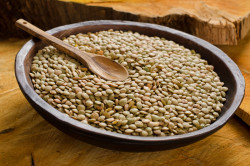The Diabetes-Nutrition Connection

November is Diabetes Awareness month, a good time to take stock of ways you can prevent this debilitating disease or reduce its effects if you already have it.
More than 30 million people in the United States have diabetes. An additional 84 million adults are at high risk of developing type 2 diabetes.
If you are at high risk for type 2 diabetes, you can lower your risk by making some healthy changes – eating healthy, getting more exercise and losing weight.
The following studies will help you increase your awareness of the connection between good nutrition and preventing or reducing the effects of diabetes.
Vitamin D Deficiency and Diabetic Retinopathy
Poorly controlled glucose levels in diabetes can cause changes in the retina of the eye that may lead to blindness. Doctors in this study wanted to know what role vitamin D might play in preventing diabetic retinopathy. Reviewing 11 publications covering 6,000 study participants, diabetics who were deficient in vitamin D were 27 percent more likely to have diabetic retinopathy than diabetics who had sufficient levels of vitamin D. The conclusion: Vitamin D may improve insulin secretion, and may also discourage abnormal blood vessel growth.
Reference: Canadian Journal of Ophthalmology; 2017; Vol. 52, No. 2, 219-24.
Curcuminoids and Lipids
People with type 2 diabetes are more likely to have heart and circulatory problems and abnormal lipid levels. Studies suggest that curcuminoids, natural compounds found in turmeric, may have anti-diabetic and lipid-regulating benefits.
However, few studies have measured the effect of curcuminoids on lipids in type 2 diabetes. In this study, 118 people aged 18 to 65 with type 2 diabetes took a placebo or a daily supplement containing 1,000 mg of curcuminoids.
After 12 weeks, those taking curcuminoids saw total cholesterol decline by 21.86 mg per deciliter of blood (mg/dL) compared to 17.06 for the placebo group. Non-HDL cholesterol decreased by 23.43 mg/dL in the curcuminoid group vs. 16.84 in the placebo group. HDL, the “good” cholesterol, increased 1.56 mg/dL for curcuminoids, while decreasing slightly for the placebo.
Reference: Complementary Therapies in Medicine; August 2017, Vol. 33, 1-5, Published Online.
Legumes and Diabetes
 People who eat more legumes and beans, especially lentils, were less likely to develop type 2 diabetes. In this study, doctors measured the diets of 3,349 older adults with higher chances of heart and circulatory disease, but without diabetes. Over four years, those who consumed more than three servings per week were 35 percent less likely to have developed type 2 diabetes, compared to those who got fewer legumes in their diets.
People who eat more legumes and beans, especially lentils, were less likely to develop type 2 diabetes. In this study, doctors measured the diets of 3,349 older adults with higher chances of heart and circulatory disease, but without diabetes. Over four years, those who consumed more than three servings per week were 35 percent less likely to have developed type 2 diabetes, compared to those who got fewer legumes in their diets.
Lentils were most beneficial, followed by chickpeas. Practicing a Mediterranean-type diet, including frequently eating legumes, may help older adults with heart and circulatory concerns avoid type 2 diabetes.
Reference: Clinical Nutrition Journal; March, 2017, Published Online.
Choline, Betaine and Insulin Resistance
Choline and betaine aid liver function, and help cells reproduce. In this study, doctors measured the diets of 2,394 adults from the general population.
Both men and women who got the most choline and betaine had the least insulin resistance, while men and women who got the least choline and betaine had the greatest insulin resistance. When insulin resistance is high, the body needs larger amounts of insulin to metabolize and use glucose or sugar. Chances for developing type 2 diabetes increase as insulin resistance becomes more severe.
Doctors said choline and betaine could help alleviate inflammation, reduce oxidative stress and help normalize metabolism, reducing chances for developing type 2 diabetes.
Reference: Nutrition Journal; January, 2017, Vol. 33, 28-34.
These statements have not been evaluated by the FDA. They are not intended to treat, diagnose, cure or prevent any disease.
